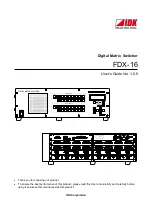
Appendix C: Status model
Models 707B and 708B Switching Matrix Reference Manual
C-6
707B-901-01 Rev. A / August 2010
As shown above, there are five register sets associated with System Event Status. These registers
summarize system status for various nodes connected to the TSP-Link
TM
. Note that all nodes on the
TSP-Link share a copy of the system summary registers once the TSP-Link has been initialized. This
feature allows all nodes to access the status models of other nodes, including SRQ.
In a TSP-Link system, the status model can be configured such that a status event in any node in the
system can set the RQS (Request for Service) bit of the Master Node Status Byte. See
(on page C-19) for details on using the status model in a TSP-Link system.
Attributes are summarized in
(on page
For example, any of the following commands will set the EXT enable bit:
status.system.enable = status.system.EXT
status.system.enable = status.system.EXTENSION_BIT
status.system.enable = 1
When reading a register, a numeric value is returned. The binary equivalent of this value indicates
which bits in the register are set. For details, see
(on page C-14). For example, the
following command will read the system enable register:
print(status.system.enable)
The bits used in the system register sets are described as follows:
•
Bit B0, Extension Bit (EXT):
Set bit indicates that an extension bit from another system status
register is set.
•
Bits B1-B14* NODE
N
:
Indicates a bit on TSP-Link node n has been set (
N
= 1 to 64).
•
Bits B15:
Not used.
*
status.system5
does not use bits B9 through B15.
Refer to the following table for available
N
values:
Command
N
value
status.system.*
1 to 14
status.system2.*
15 to 28
status.system3.*
29 to 42
status.system4.*
43 to 56
status.system5.*
57 to 64
















































